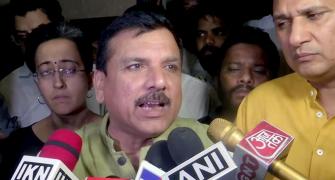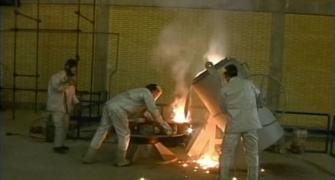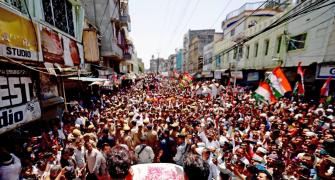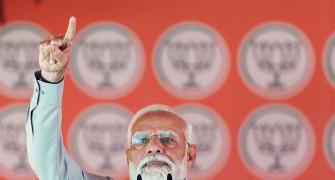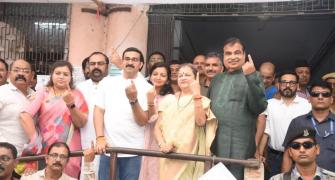The economy never had it so good as in the year gone by, but chronic problems of poverty, hunger, unemployment, regional disparities and inequalities among citizens continued to plague India, casting their dark shadows over the spectacular achievements.
The economy did remarkably well in 2005, whether viewed in terms of GDP growth, buoyancy in stock markets, an impending investment boom and the new-found confidence in the country among foreigners.
While the city dwellers revelled in the consumerist boom, the man on the street, such as pensioners, shuddered to think how they would protect their measly income and whether even their children will have a better future. Malnourished children straddling along road pavements and seeking alms were the pictures of the year along with confident and smiling CEOs.
The better off urbanites rarely worry as to how the other half -- the teeming mass of the poor -- live or die, being too busy in carving out a better deal for themselves. Their struggle too is intense. Liberalisation and competition have a logic of their own -- often unleashing insecurity and uncertainty.
In India, the sun shines only on a few. Villagers, who form a bulk of the population, rarely benefit from any government scheme in any significant way.
More than 400 million countrymen are under-employed, not adequately fed or educated, under-clad and without a proper roof under their heads.
But the brighter side of the economy is indeed impressive.
Inflation for most of the year remained low in the region of five per cent, interest rates were benign, soaring global oil prices could not depress GDP growth reflecting the enhanced efficiency of the services and manufacturing sectors, and tax revenues were buoyant.
But, above all the economy is well poised to clock a growth rate of seven per cent-plus in 2005-06.
Add to this the comfortable foreign exchange reserves of nearly $150 billion, the outstanding performance of the IT sector, the ostensible success of Non-Resident Indian professionals in the United States and the reverse brain drain, and the country's phenomenal achievements in sectors such as telecom, pharmaceuticals and biotechnology.
The negativities of the situation entail the more than 26 per cent population still below poverty line, the problems of survival and exclusion, the growing Bharat-India divide, the stodginess of our institutional structures, and the obsolete rules and regulations governing Indians.
Old mindsets make it difficult to comprehend the many dramatic changes making the Indian State and society. A young people in an old country, simultaneously occupying multiple, conflicting possibly incommensurate worlds.
The black economy, which is privately estimated to be nearly 40 per cent of the national income, is the biggest cause of failure of economic policy. Ironically, the government has no estimates of its own to go by.
In the past three years, India has steadily moved on to the radar screens of governments and corporates across the world.
First, as a mega-consumer and as a value-for-money service provider, then as a fiesty negotiator at the WTO and, more recently, as a research hub and knowledge-driven manufacturing base. India indeed has grabbed centrestage among emerging markets.
In the 90s, India averaged a growth rate of 6.4 per cent. In December 2005, the Centre for Monitoring the Indian Economy revised the country's 2005-06 growth forecast for the current year to 7.6 per cent, in the background of strong performances from the services and manufacturing sectors. This is the third successive year in which GDP is expected to grow at over 7 per cent.
The 'India Story' has sold itself well among investors, domestic or foreign, be they in the stock markets or brick and mortar companies.
FDI too is on an upswing. It grew from $2-3 billion dollars during the National Democratic Alliance regime on an average to $3.7 billion last year and a possible $5 billion this year. The outward flow of FDI too is an upward rising curve, with Indian companies acquiring firms in several countries and across many sectors. The Indian flows have been strikingly high to the United Kingdom.
But a more impressive feature has been some big ticket FDI in India. The $1.5 billion purchase of 10 per cent stake in Bharati by Vodafone, Merrill's buying a stake in DSP for $500 million, Posco making announcement of 13 billion dollars for a steel plant in Orrisa -- the largest FDI commitment till date, Cisco, Intel and Microsoft's announcement of billion-dollar investment plans within weeks of each other are only illustrative.
The Sallem Group's of Industries of Indonesia agreeing to set up an Industrial Town Ship in West Bengal involving an investment of Rs 250 crore (Rs 2.5 billion) stirred the hornet's nest. The Sallem event, however, brought to the fore the internal contradictions between hard liners in the CPI(M) and reformist leaders like West Bengal Chief Minister Buddhadev Bhattcharaya.
The year saw the continuation of the roaring bull market which begin around March 2003. The capital markets have been on a roll and have more than doubled over the past 30-odd months. FII's seem to have rediscovered Indian markets pouring more than $10 billion in 2005 after pumping in more than $8 billion in 2004.
Towards the end of 2005 domestic investor's too joined the party, as flows into mutual funds surged in the last six months in the current year. A major development was the broadening of flows into the stock markets as Japanese investors for the first time participated in the bourses with more than $3 billion in 'India dedicated funds' raised in Japan alone.
The Sensex reached hostoric highs and it is difficult to say where it will settle.
The love story of foreign investors was so intense that they become oblivious of the fact that the reform process had hit a roadblock. This was particularly so in the areas of PSU divestment, labour and power sector reforms.
Here is some stocktaking on reforms.
- While FDI caps were raised in the telecom and civil aviation sectors, in Insurance the left parties stuck to there stand of not permitting any hike of the ceiling.
- The FDI in the retail sector continued to hog the front pages of newspapers with the left parties unrelenting.
- The Investment Commission has yet to announce its interim recommendations, having failed to meet its deadline in June. The National Manufacturing Competitiveness Council, set up in December 2004, is not fully functional.
- The National Commission for unorganized sector is also not fully operative.
- The Special Purpose Vehicle for funding infrastructure projects has yet to see action. The restructuring and modernization of Metro Airports is in a muddle.
- The much talked about bank consolidation has yet to take off.
- Power sector reforms remain mainly on paper with reluctance of State governments to restructure the State Electricity Boards.
In December, Prime Minister Manmohan Singh mooted setting up of an Empowered Committee of Chief Ministers, on the lines of Empowered Committee on VAT, to work out a consenus on power reforms. Says Nilotpal Basu, CPI(M) leader in Rajya Sabha, "There is a re-think or reforms across political parties."
The most illustrative feature of the year was the tug of war between the United Progressive Alliance government and its supporting Left parties. The situation often became so heated that some even suggested that the Congress party renounce its support of the left parties, announce elections and get a fresh mandate.
Bullion during the year touched its highest ever and real estate prices skyrocketed. It is a rare phenomenon that the stock markets, the bullion trade and the real estate market are in a boom at the same time. Often money flows from one segment to another, but 2005 in this sense was an exception.
The two most significant events took place towards the close of the year -- the ASEAN summit, as well as the first ever South East Asian summit in Kuala Lampur and the Hong Kong Ministerial. The ASEAN summit paved the way for an Asian economic market on the lines of NAFTA and the European Union. An FTA is under negotiation with the ten ASEAN member countries.
A Preferential Trade Agreement (PTA) is being discussed with China, which has captured the commanding heights of World markets.
India has already signed an FTA with Singapore and Thailand. It is also considering an FTA with Korea and Japan. The implications of these arrangements will be known only after a few years, say a decade. But, it is as clear as the day that Indian economy is increasingly getting enmeshed with the global economy and will embrace a still more free economy, where tariff rates will touch the rock bottom.
The prime minister, as also many others, are convinced that the new century belongs to Asia, and India along with China were poised to assume their rightful place in the comity of nations. The sixth WTO Ministerial was surprisingly not quite the debacle the world was expecting. Last minute negotiations managed to keep the Round on track by pinning down dates for the European Union to phase out agricultural export subsidies and the United States to reduce its subsidies to cotton farmers.
India emerged as a champion of developing countries rallying them to get a better deal at Hong Kong. The pressure is on to deliver the Doha round by next year.
The issue is whether the 149 squabbling members of the WTO can find enough common ground. The key constraints to future growth are agriculture, which contributes to about 22 per cent of the GDP but on which 67 per cent of the population is still dependent, and infrastructure development.
The official thinking is that agricultural growth has suffered from neglect in recent years. From around a growth rate of 3.2 per cent a year during 1980s to mid 1990s, it decelerated sharply to less than 2 per cent.
The Planning Commission is of the view that it is necessary to accelerate it to around 4 per cent to achieve a GDP growth rate of 8 per cent. The recipe suggested by the Commission is to hike public investment in irrigation, invest in rural roads, create rural infrastructure, improve credit delivery to rural areas, shift production in favour of horticultural crops, dairy and poultry development and value addition through better marketing and agro-processing.
Lack of infrastructure development is now perceived as the key constraint to industrial development as well as considered necessary to improve the condition of rural areas. Its requirements have been estimated to be in excess of $150 billion and the prime minister himself is heading a committee to give the import it deserves. The Plan extends to building and upgradation of roads, seaports and airports.
India thus emerges as a tale of two cities -- the rich and the poor -- the intervening space being occupied by various shades of economic classes.
The economic reforms launched in 1991 focussed attention exclusively on the opening up of the Indian economy and on broadening the reach of markets. But the lack of any initiative in the initial years, at least to bring about a radical change in the social sectors, is often cited as a major failure with negative implications on the prospects of improving the living conditions and the chances of success of market reforms themselves.
The issues underlying the liberalisation are not, of course, trivial, but engagement on these matters -- in opposition or in defence -- cannot justify the conformist tranquility on the neglected provision of public education, health care and the direct means of promoting human capabilities.
The government did, however, launch a number of initiatives in this regard -- the Rs 174,000 crore (Rs 1,740 billion) Bharat Nirman programme aimed at improving rural infrastructure, Sarva Siskha Abhiyan, and the Rural Health Mission to name but a few.
However, without improving the delivery mechanisms and institutional reform their success is suspect. If the right steps are not taken, 'Bharat' will not look very beautiful.
